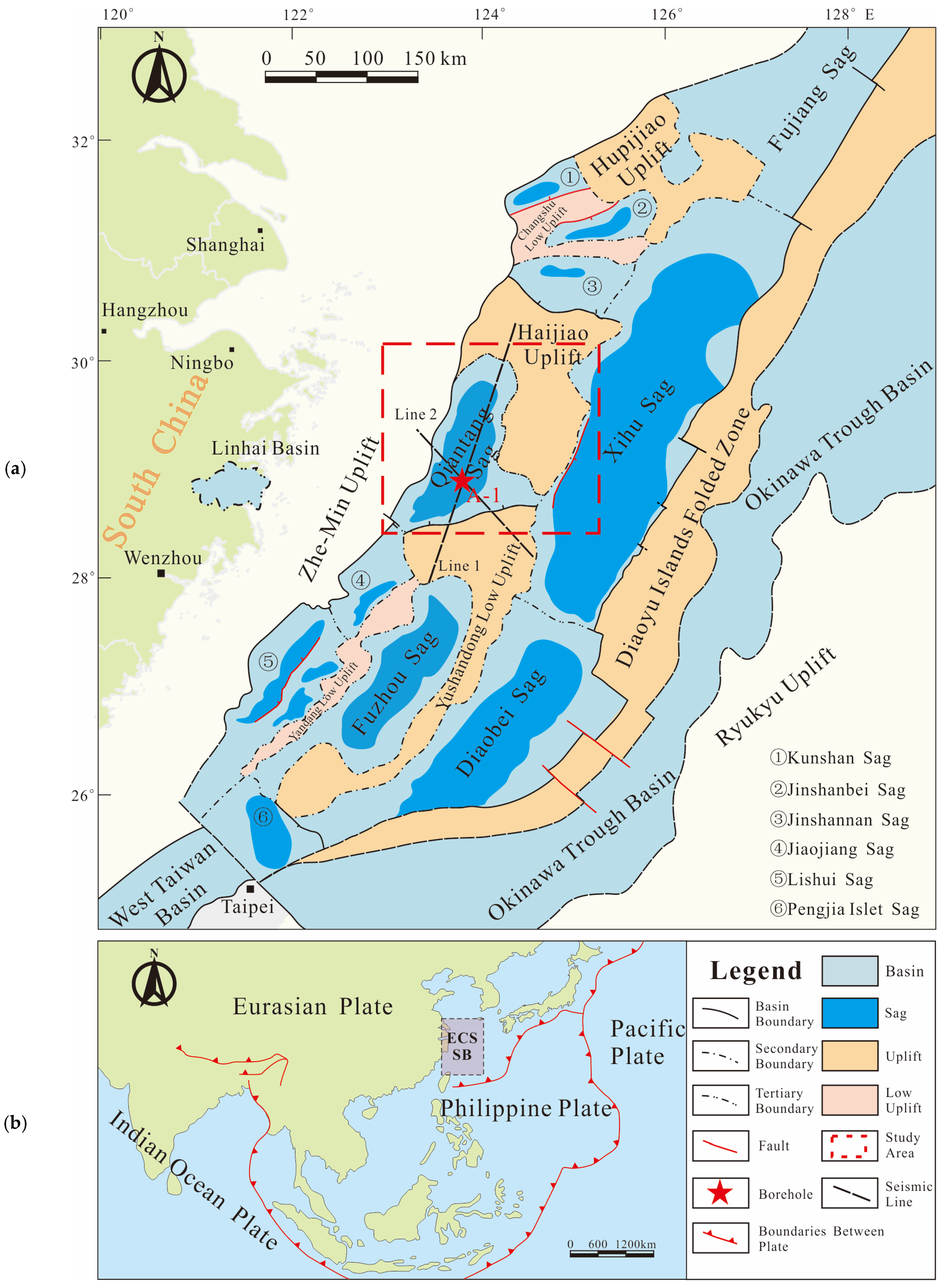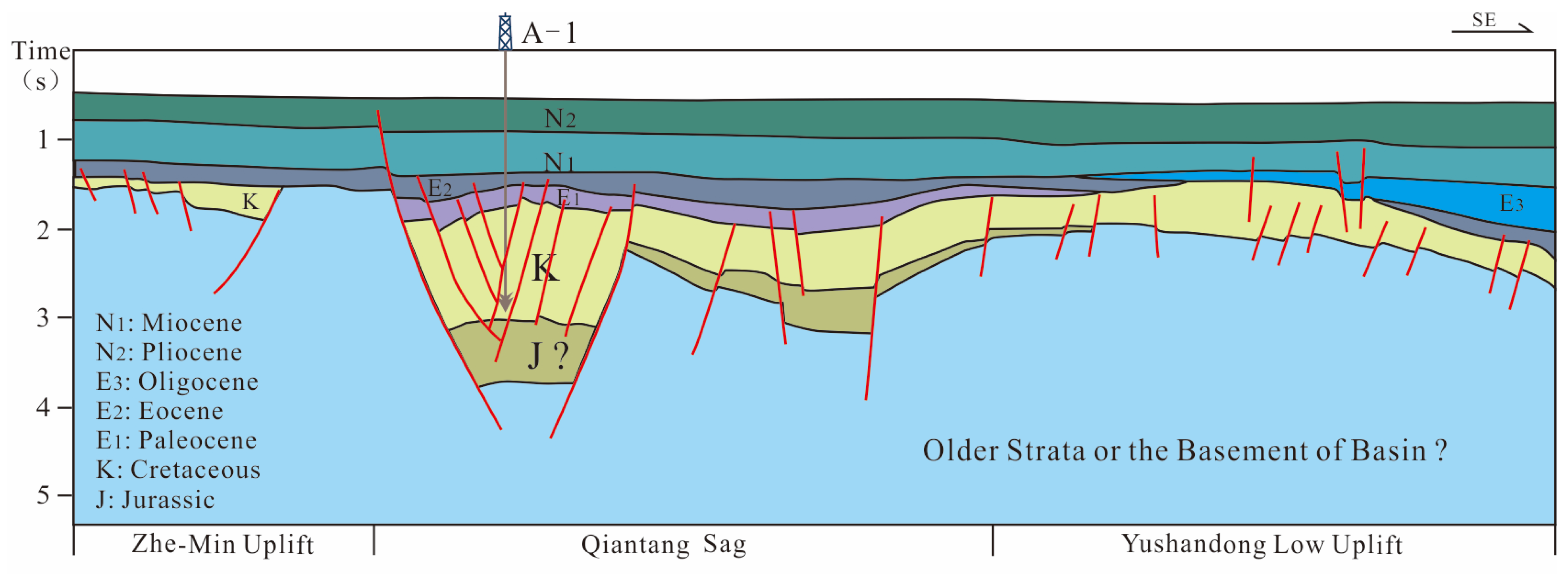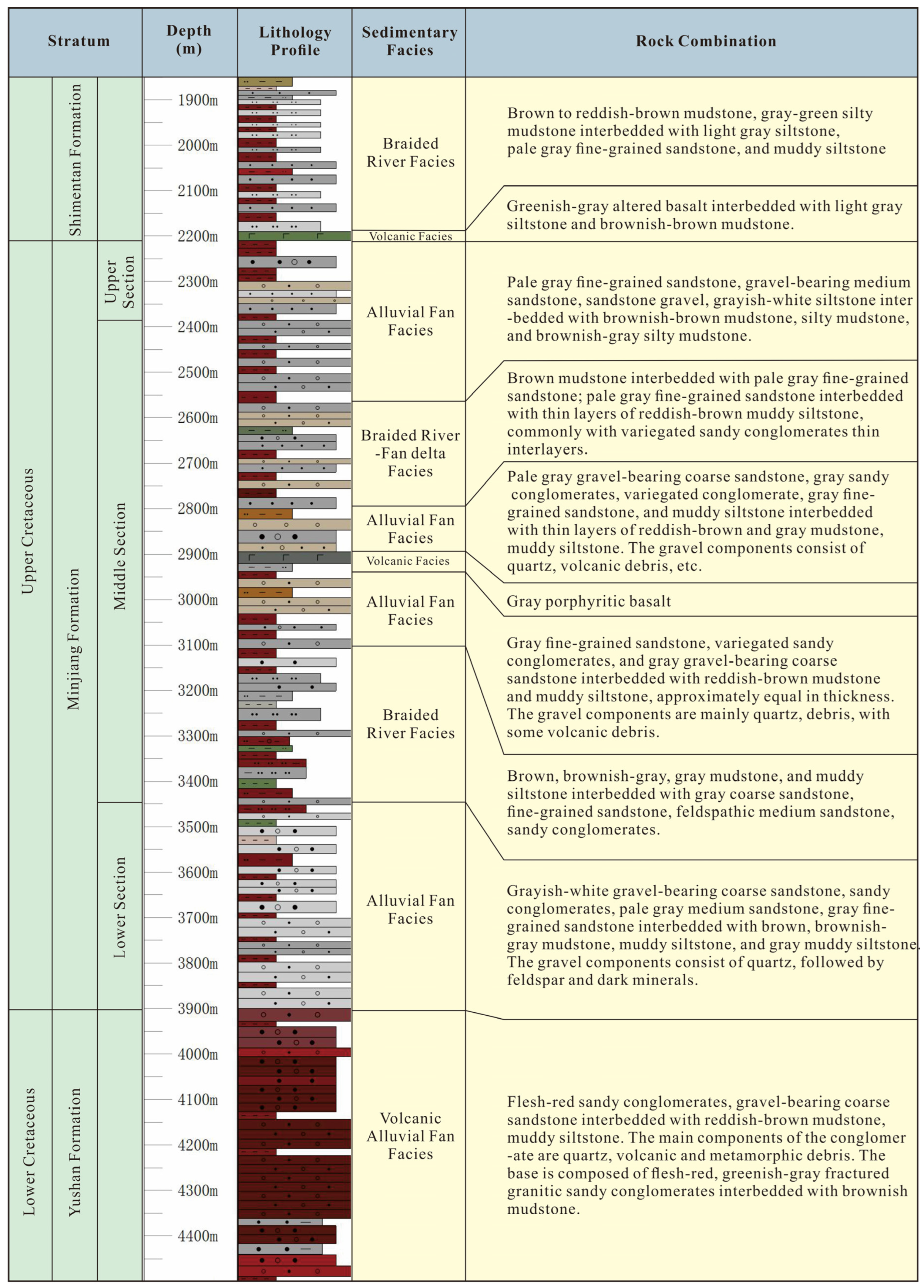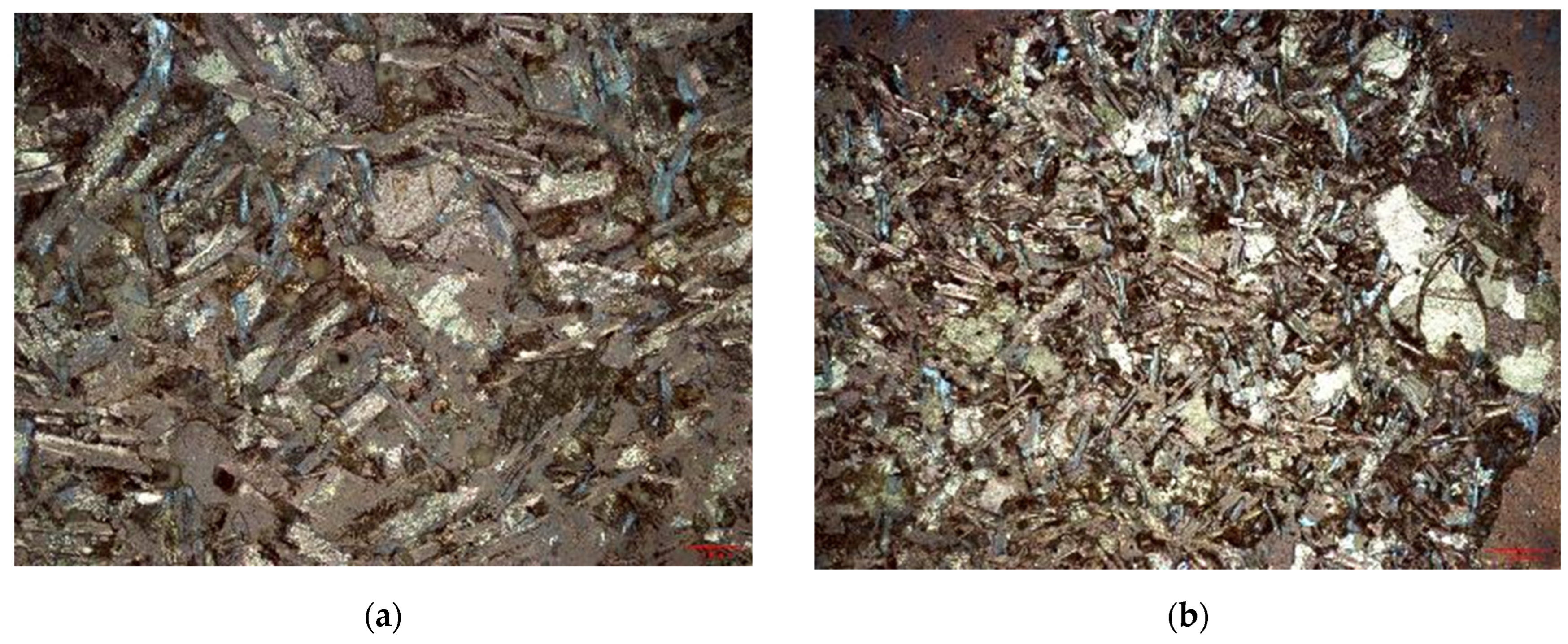Study of Cretaceous Provenance Tracing and Sedimentary Patterns in the Western Qiantang Sag, East China Sea Shelf Basin
Abstract
:1. Introduction
2. Geological Setting

3. Materials and Methods
3.1. Data and Materials
3.2. Methods
3.2.1. Seismic Data Study and Application
3.2.2. Preparation and Observation of Microscopic Thin Sections
3.2.3. Core Observation
3.2.4. Detrital Zircon Sample Preparation and Analysis Methods
4. Results
4.1. Stratigraphic Characteristics and Sedimentary Sequence
4.1.1. Sag Structure and Stratigraphic Distribution
4.1.2. Vertical Stratigraphic Features and Sedimentary Sequence
4.2. Detrital Zircon Provenance Analysis

5. Discussion
5.1. Discussion on Provenance
5.2. Discussion on Sedimentary Models
5.2.1. Discussion of Key Conditions
5.2.2. Multi-Phase Sedimentary Evolution Model
6. Conclusions
Author Contributions
Funding
Institutional Review Board Statement
Informed Consent Statement
Data Availability Statement
Acknowledgments
Conflicts of Interest
References
- Hilde, T.W.C.; Uyeda, S.; Kroenke, L. Evolution of the western Pacific and its margin. Tectonophysics 1977, 38, 155–165. [Google Scholar] [CrossRef]
- Zhu, W.L.; Zhong, K.; Fu, X.W.; Chen, C.F.; Zhang, M.Q.; Gao, S.L. The formation and evolution of the East China Sea Shelf Basin: A new view. Earth-Sci. Rev. 2019, 190, 89–111. [Google Scholar] [CrossRef]
- Yang, C.; Li, S.Z.; Li, G.; Yang, C.; Yang, Y.Q.; Dai, L.; Suo, Y.; Li, Q.; Jiang, Y. Tectonic units and proto-basin of the East China Sea Shelf Basin: Correlation to Mesozoic subduction of the Palaeo-Pacific Plate. Geol. J. 2016, 51, 149–161. [Google Scholar] [CrossRef]
- Yang, C.; Sun, J.; Yang, Y.Q.; Yang, C.; Wang, J.; Xiao, G.; Wang, J. Key factors controlling Mesozoic hydrocarbon accumulation in the Southern East China Sea Basin. Mar. Pet. Geol. 2020, 118, 104436. [Google Scholar] [CrossRef]
- Su, A.; Chen, H.; Chen, X.; He, C.; Liu, H.; Li, Q.; Wang, C. The characteristics of low permeability reservoirs, gas origin, generation, and charge in the central and western Xihu Depression, East China Sea Basin. J. Nat. Gas Sci. Eng. 2018, 53, 94–109. [Google Scholar] [CrossRef]
- Zhong, K.; Wang, X.; Zhang, T.; Zhang, M.; Fu, X.; Guo, M. Distribution of residual Mesozoic basins and their exploration potential in the western depression zone of East China Sea Shelf Basin. Mar. Geol. Quat. Geol. 2019, 39, 41–51, (In Chinese with English Abstract). [Google Scholar]
- Zhong, K.; Zhu, W.; Gao, S.; Fu, X. Key geological questions of the formation and evolution and hydrocarbon accumulation of the East China Sea Shelf Basin. Earth Sci. 2018, 43, 3485–3497, (In Chinese with English Abstract). [Google Scholar]
- Li, S.; Shao, L.; Liu, J.; Qin, L.; Kang, S.; Eriksson, K.A. Oil generation model of the liptinite-rich coals: Palaeogene in the Xihu Sag, East China Sea Shelf Basin. J. Petrol. Sci. Eng. 2022, 209, 109844. [Google Scholar] [CrossRef]
- Ding, F.; Xie, C.; Zhou, X.; Jiang, C.; Li, K.; Wan, L.; Zhang, P.; Niu, H. Defining stratigraphic oil and gas plays by modifying structural plays: A case study from the Xihu Sag, east China Sea Shelf Basin. Energy Geosci. 2021, 2, 41–51. [Google Scholar] [CrossRef]
- Su, A.; Chen, H.; Cao, L.; Lei, M.; Wang, C.; Liu, Y.; Li, P. Genesis, source, and charging of oil and gas in Lishui sag, East China Sea Basin. Pet. Explor. Dev. 2014, 41, 574–584. [Google Scholar] [CrossRef]
- Ye, J.R.; Gu, H.R.; Jia, J.Y. Research on the hydrocarbon accumulation dynamics of Xihu Sag, East China Sea Shelf Basin. J. Nat. Gas Ind. 2005, 25, 5–8. [Google Scholar]
- Ye, J.R.; Qing, H.R.; Bend, S.L.; Gu, H.R. Petroleum systems in the offshore Xihu Basin on the continental shelf of the East China Sea. AAPG Bull. 2007, 91, 1167–1188. [Google Scholar] [CrossRef]
- Wang, D.; Li, H.; Lu, Y. Geochemical characteristics and distribution of Mesozoic hydrocarbon source rocks in the southern part of East China Sea. Offshore Oil 2015, 35, 1–6, (In Chinese with English Abstract). [Google Scholar]
- Zhu, X.; Chen, J.; Li, W.; Pei, L.; Liu, K.; Chen, X.; Zhang, T. Hydrocarbon generation potential of Paleogene coal and organic-rich mudstones in Xihu Sag, East China Sea Shelf Basin, offshore eastern China. J. Pet. Sci. Eng. 2019, 184, 106450. [Google Scholar] [CrossRef]
- Ruobing, L. Analysis of Hydrocarbon Exploration Potential in the Mesozoic of the Southern East China Sea Shelf Basin. Offshore Oil 2017, 37, 16–22, (In Chinese with English Abstract). [Google Scholar]
- Yang, C.; Yang, C.; Li, G.; Yang, Y.; Sun, J.; Yan, Z.; Wang, J. Prospecting of Meso-Cenozoic hydrocarbon in the East China Sea Shelf Basin. Mar. Geol. Quat. Geol. 2018, 38, 136–147, (In Chinese with English Abstract). [Google Scholar]
- Jiang, S.; Li, S.; Chen, X.; Zhang, H.; Wang, G. Simulation of oil–gas migration and accumulation in the East China Sea Continental Shelf Basin: A case study from the Xihu Depression. Geol. J. 2016, 51, 229–243. [Google Scholar] [CrossRef]
- Lee, G.H.; Kim, B.Y.; Shin, K.S.; Sunwoo, D. Geological evolution and aspects of the petroleum geology of the northern East China Sea shelf basin. AAPG Bull. 2006, 90, 237–260. [Google Scholar] [CrossRef]
- He, J.; Zhang, W.; Yan, W.; Lu, Z.; Zhang, J.; Gong, X. Episodic tectonic evolution, Basin types, and hydrocarbon accumulation in Chinese Marginal Basins. Mar. Geol. Quat. Geol. 2014, 34, 121–134, (In Chinese with English Abstract). [Google Scholar] [CrossRef]
- Li, S.; Zhao, G.; Dai, L.; Liu, X.; Zhou, L.; Santosh, M.; Suo, Y. Mesozoic basins in eastern China and their bearing on the deconstruction of the North China Craton. J. Asian Earth Sci. 2012, 47, 64–79. [Google Scholar] [CrossRef]
- Gong, J.; Li, G.; Yang, C.; Xu, X.; Zhang, J.; Wang, H.; Xu, L. Hydrocarbon Prospecting of Mesozoic Strata in Southern East China Sea Shelf Basin. J. Jilin Univ. 2013, 43, 20–27, (In Chinese with English Abstract). [Google Scholar]
- Cukur, D.; Horozal, S.; Lee, G.; Kim, D.-C.; Han, H.-C. Timing of trap formation and petroleum generation in the northern East China Sea Shelf Basin. Mar. Petrol. Geol. 2012, 36, 154–163. [Google Scholar] [CrossRef]
- Liang, X.; Chen, S.; Ma, B.; Ding, B.; Liang, Y.; Song, X.; Zhou, J.; Yu, Y.; Yu, L. Changes of tectonic regime of the East China Sea Shelf Basin since Mesozoic: Insights from the Tiantai slope belt, East China Sea. J. Asian Earth Sci. 2024, 259, 105900. [Google Scholar] [CrossRef]
- Chen, J.; Li, G.; Chen, G. Petroleum prospects of Mesozoic and Paleocene in the western depression of the East China Sea shelf basin. Mar. Geol. Lett. 2003, 19, 17–19, (In Chinese with English Abstract). [Google Scholar]
- Liang, J.; Chen, J.; Zhang, Y.; Yang, Y.; Li, G.; Li, Q.; Dong, G.; Yang, C. Type and origin of Mesozoic reservoirs in western depression zone of East China Sea shelf basin. Mar. Geol. Quat. Geol. 2016, 36, 131–138, (In Chinese with English Abstract). [Google Scholar]
- Gurnis, M.; Turner, M.; Zahirovic, S.; DiCaprio, L.; Spasojevic, S.; Müller, R.; Boyden, J.; Seton, M.; Manea, V.C.; Bower, D. Plate tectonic reconstructions with continuously closing plates. Comput. Geosci. 2012, 38, 35–42. [Google Scholar] [CrossRef]
- Hall, R. Cenozoic geological and plate tectonic evolution of SE Asia and the SW Pacific: Computer-based reconstructions, model and animations. J. Asian Earth Sci. 2002, 20, 353–431. [Google Scholar] [CrossRef]
- Northrup, C.J.; Royden, L.H.; Burchfiel, B.C. Motion of the Pacific plate relative to Eurasia and its potential relation to Cenozoic extension along the eastern margin of Eurasia. Geology 1995, 23, 719–722. [Google Scholar] [CrossRef]
- Changqing, Y.; Yanqiu, Y.; Gang, L.I.; Chuansheng, Y.; Jinyu, Y. The Mesozoic Basin-Mountain Coupling Process of the Southern East China Sea Shelf Basin and its Adjacent Land Area. Acta Geol. Sin. (Engl. Ed.) 2016, 90, 1051–1052. [Google Scholar] [CrossRef]
- Han, H.-C.; Lee, Y.S.; Hwang, J.S.; Lee, S.-G.; Yoon, Y.; Stagpoole, V. Geophysical characteristics of the Hupijiao Rise and their implication to Miocene volcanism in the northeastern part of the East China Sea. Mar. Geol. 2015, 363, 134–145. [Google Scholar] [CrossRef]
- Li, Z.X.; Li, X.H.; Chung, S.L.; Lo, Q.H.; Xu, X.S.; Li, W.X. Magmatic switch-on and switch-off along the South China continental margin since the Permian: Transition from an Andean-type to a Western Pacific-type plate boundary. Tectonophysics 2012, 532–535, 271–290. [Google Scholar] [CrossRef]
- Xu, Q.-J.; Liu, S.; Wang, Z.; Zhang, B. Provenance of the East Guangdong Basin and Yong’an Basin in Southeast China: Response to the Mesozoic Tectonic Regime Transformation. J. Asian Earth Sci. 2019, 185, 104024. [Google Scholar] [CrossRef]
- Lee, C.; Shinn, Y.J.; Ryu, I.C. Development of regional uplift and uplift-related strata in Gunsan Basin, Yellow Sea: Implications for Cenozoic crustal extension. Int. Geol. Rev. 2016, 58, 2029–2045. [Google Scholar] [CrossRef]
- De-Zhang, G.; Jian, T.; Yu-Ling, B.O. Study on the Distribution of Mesozoic and Paleozoic Layer in Haijiao Doming and Qiantang Depression in the East China Sea. Offshore Oil 2005, 25, 1–6, (In Chinese with English Abstract). [Google Scholar]
- Zhao, L. Study on Paleogene Sedimentary System of East China Sea Shelf Basin. Master’s Thesis, China University of Geosciences, Beijing, China, 2005. (In Chinese with English Abstract). [Google Scholar]
- Xia, Q. Cenozoic Sedimentary System and Lithofacies Paleo-Geography in the East China Sea Shelf Basin. Master’s Thesis, China University of Geosciences, Beijing, China, 2005. (In Chinese with English Abstract). [Google Scholar]
- Jiang, Y.; He, X.; Zhang, S. The Characteristics of “Inverse-transform” Tectonic Migration Evolution of the East China Sea Shelf Basin—By Taking the Marginal Structure of Xihu Sag for Example. J. Yangtze Univ. (Nat. Sci. Ed.) 2016, 13, 1–8, (In Chinese with English Abstract). [Google Scholar]
- Guan, D.; Ke, X.; Wang, Y. Basement structures of East and South China Seas and adjacent regions from gravity inversion. J. Asian Earth Sci. 2016, 117, 242–255. [Google Scholar] [CrossRef]
- Wang, Q.; Li, S.-Z.; Guo, L.-L.; Suo, Y.; Dai, L. Analogue modelling and mechanism of tectonic inversion of the Xihu Sag, East China Sea Shelf Basin. J. Asian Earth Sci. 2017, 139, 129–141. [Google Scholar] [CrossRef]
- Zhu, W.; Xu, X.; Wang, B.; Cao, Q.; Chen, C.; Gao, S.; Feng, K.; Fu, X. Late Mesozoic continental arc migration in southern China and its effects on the evolution of offshore forearc basins. Earth Sci. Front. 2022, 29, 277–290, (In Chinese with English Abstract). [Google Scholar] [CrossRef]
- Ding, W.; Li, J.; Wu, Z.; Li, S.; Lin, X. Late Mesozoic transition from Andean-type to Western Pacific-type of the East China continental margin—Is the East China Sea basement an allochthonous terrain? Geol. J. 2017, 53, 1994–2002. [Google Scholar] [CrossRef]
- Suo, Y.; Li, S.-Z.; Zhao, S.-J.; Somerville, I.; Yu, S.; Dai, L.; Xu, L.; Cao, X.; Wang, P. Continental margin basins in East Asia: Tectonic implications of the Meso-Cenozoic East China Sea pull-apart basins. Geol. J. 2015, 50, 139–156. [Google Scholar] [CrossRef]
- Wang, K.-L.; Chung, S.-L.; Lo, Y.; Lo, C.; Yang, H.; Shinjo, R.; Lee, T.; Wu, J.-C.; Huang, S. Age and geochemical characteristics of Paleogene basalts drilled from western Taiwan: Records of initial rifting at the southeastern Eurasian continental margin. Lithos 2012, 155, 426–441. [Google Scholar] [CrossRef]
- Xu, C.; Zhang, L.; Shi, H.; Brix, M.; Huhma, H.; Chen, L.-H.; Zhang, M.; Zhou, Z. Tracing an early Jurassic magmatic arc from South to East China Seas. Tectonics 2017, 36, 466–492. [Google Scholar] [CrossRef]
- Lin, A.T.; Watts, A.B.; Hesselbo, S.P. Cenozoic stratigraphy and subsidence history of the South China Sea margin in the Taiwan region. Basin Res. 2003, 15, 453–478. [Google Scholar] [CrossRef]
- Xu, J.; Kelty, T.; Ben-Avraham, Z.; Yu, H. Origin of marginal basins of the NW Pacific and their plate tectonic reconstructions. Earth-Sci. Rev. 2014, 130, 154–196. [Google Scholar] [CrossRef]
- Fu, X.; Ding, W.; Dadd, K.; Li, J.; Zhu, W.; Feng, K.; Geng, J.; Xu, X. An exotic origin of the eastern East China Sea basement before −150 Ma. Sci. Bull. 2022, 67, 1939–1942. [Google Scholar] [CrossRef] [PubMed]
- Zhao, Y. Analysis of Oil and Gas Conditions of the Mesozoic in the East China Sea Shelf Basin. Master’s Thesis, China University of Geosciences (Beijing), Beijing, China, 2005. (In Chinese with English Abstract). [Google Scholar]
- Xu, C.; Deng, Y.; Barnes, C.G.; Shi, H.; Pascal, C.; Li, Y.; Gao, S.; Jiang, D.; Xie, J.; Ma, C. Offshore-onshore tectonomagmatic correlations: Towards a Late Mesozoic non-Andean-type Cathaysian continental margin. Earth-Sci. Rev. 2023, 240, 104382. [Google Scholar] [CrossRef]
- Qiu, J.T.; Mu, H.X.; Rui, X.M.; Yang, Y.J.; Li, P.; Qiu, L.; Xu, C.B. The Relationships between Danxia Geoheritages and Regional Tectonics in Southern Sichuan Basin: Implications for the Spatial Distribution of Danxia Landforms in China. Geoheritage 2024, 16, 24. [Google Scholar] [CrossRef]
- Liu, D.; Wang, C.; Zhang, X.; Hu, Y.; Wang, J.; Yan, K.; Yu, X.; Hu, H.; Lv, D.; Liu, X. Evidence of huge evaporite mine clusters under extreme arid climatic conditions of Cretaceous to Paleogene in South China: Example of the Huichang large salt deposit. Ore Geol. Rev. 2024, 165, 105899. [Google Scholar] [CrossRef]
- Zheng, C.; Wang, J.; Li, X.; Zhang, C. Intermontane erg environment and arid climate indicated from associated eolian and alluvial fan facies during the Late Cretaceous, South China. J. Asian Earth Sci. 2024, 264, 106044. [Google Scholar] [CrossRef]
- Chen, J.N.; Mao, X.G.; Shi, Y.H.; Liu, X.M. Study on the Late Cretaceous paleoenvironment documented by red beds in the western Fujian province. Chin. J. Geophys. 2020, 63, 1553–1568. [Google Scholar] [CrossRef]
- Li, X.; Chen, S.; Cao, K.; Chen, Y.; Xu, B.; Ji, Y. Paleosols of the Mid-Cretaceous: A Report from Zhejiang and Fujian, SE China. Earth Sci. Front. 2009, 16, 63–70. [Google Scholar] [CrossRef]
- Chen, L.; Guo, F.; Steel, R.; Li, Y. Petrography and geochemistry of the Late Cretaceous redbeds in the Gan-Hang Belt, southeast China: Implications for provenance, source weathering, and tectonic setting. Int. Geol. Rev. 2016, 58, 1196–1214. [Google Scholar] [CrossRef]
- Yang, Y.; Jiang, Z.; Jiang, X. The Cretaceous Sedimentary Environments and Tectonic Setting of the Southern East China Sea Shelf Basin. Energies 2023, 16, 4205. [Google Scholar] [CrossRef]
- Al-Masgari, A.A.; Elsaadany, M.; Latiff, A.H.A.; Imran, Q.S. A guideline for seismic sequence stratigraphy interpretation. J. Eng. Appl. Sci. 2021, 16, 165–183. [Google Scholar]
- SY/T 5368–2016; Identification of Rock Flakes. The Standardization Administration of the People’s Republic of China: Beijing, China, 2016.
- Lai, J.; Wang, G.; Pang, X.; Fan, X.; Zhou, Z.; Si, Z.; Xie, W.; Qin, Z. Effect of Pore Structure on Reservoir Quality and Oiliness in Paleogene Dongying Formation Sandstones in Nanpu Sag, Bohai Bay Basin, Eastern China. Energy Fuels 2018, 32, 9220–9232. [Google Scholar] [CrossRef]
- Zhao, S.; Fu, Q.; Fu, J.; Liu, X.; Li, S.; Zhang, G.; Teng, J. Effect of authigenic clay minerals and carbonate cements on quality of tight sandstone reservoirs: Insight from Triassic tight sandstones in the Huaqing area, Ordos Basin, Northern China. J. Asian Earth Sci. 2022, 229, 105099. [Google Scholar] [CrossRef]
- Tian, J.; Liang, Q.; Wang, F.; Li, J.; Yu, W.; Chen, W. Sedimentary records of seismic events in a lacustrine basin of continental depression: A case study of the Triassic Yanchang Formation in the Ordos Basin, Northern China. J. Asian Earth Sci. 2022, 228, 105128. [Google Scholar] [CrossRef]
- Fedo, C.M.; Sircombe, K.N.; Rainbird, R.H. Detrital Zircon Analysis of the Sedimentary Record. Rev. Mineral. Geochem. 2003, 53, 277–303. [Google Scholar] [CrossRef]
- Fonneland, H.; Lien, T.; Martinsen, O.; Pedersen, R.; Košler, J. Detrital zircon ages: A key to understanding the deposition of deep marine sandstones in the Norwegian Sea. Sediment. Geol. 2004, 164, 147–159. [Google Scholar] [CrossRef]
- Hu, Z.; Zhang, W.; Liu, Y.; Gao, S.; Li, M.; Zong, K.; Chen, H.; Hu, S. “Wave” Signal-Smoothing and Mercury-Removing Device for Laser Ablation Quadrupole and Multiple Collector ICPMS Analysis: Application to Lead Isotope Analysis. Anal. Chem. 2015, 87, 1152–1157. [Google Scholar] [CrossRef] [PubMed]
- Wiedenbeck, M.; Allé, P.; Corfu, F.; Griffin, W.L.; Meier, M.; Oberli, F.; Quadt, A.; Roddick, J.C.; Spiegel, W. Three natural zircon standards for U-Th-Pb, Lu-Hf, trace element, and REE analyses. Geostand. Geoanal. Res. 1995, 19, 1–23. [Google Scholar] [CrossRef]
- Pearce, N.; Perkins, W.; Westgate, J.; Gorton, M.P.; Jackson, S.; Neal, C.; Chenery, S. A compilation of new and published major and trace element data for NIST SRM 610 and NIST SRM 612 glass reference materials. Geostand. Newslett. 1997, 21, 115–144. [Google Scholar] [CrossRef]
- Liu, Y.; Hu, Z.; Gao, S.; Günther, D.; Xu, J.; Gao, C.; Chen, H. In situ analysis of major and trace elements of anhydrous minerals by LA-ICP-MS without applying an internal standard. Chem. Geol. 2008, 257, 34–43. [Google Scholar] [CrossRef]
- Liu, Y.; Hu, Z.; Zong, K.; Gao, C.; Gao, S.; Xu, J.; Chen, H. Reappraisement and refinement of zircon U-Pb isotope and trace element analyses by LA-ICP-MS. Chin. Sci. Bull. 2010, 55, 1535–1546. [Google Scholar] [CrossRef]
- Barosh, P.J. Paleozoic Rifting in New England, New Brunswick and Nova Scotia, U.S.A. and Canada. In Basement Tectonics 10. Proceedings of the 10th International Conferences on Basement Tectonics, Duluth, MN, USA, 1–11 August 1992; Ojakangas, R.W., Dickas, A.B., Green, J.C., Eds.; Springer: Dordrecht, Germany, 1995; Volume 4, p. 4. [Google Scholar] [CrossRef]
- Landing, E.; Webster, M. Iapetan rift–passive margin transition in NE Laurentia and eustatic control on continental slope oxygenation, Taconic slate colors, and Early Paleozoic climate. In Guidebook to Field Trips in New York, Vermont, and Massachusetts: 110th New England Intercollegiate Geological Conference and 90th New York Geological Association, Lake George, NY, USA, 12–14 October 2018; pp. A5–A45. Available online: https://www.nysm.nysed.gov/staff-publications/iapetan-rift%E2%80%92passive-margin-transition-ne-laurentia-and-eusta (accessed on 7 March 2024).
- Tobin, R.C.; Schwarzer, D. Effects of sandstone provenance on reservoir quality preservation in the deep subsurface: Experimental modelling of deep-water sand in the Gulf of Mexico. Geol. Soc. Lond. Spec. Publ. 2014, 386, 27–47. [Google Scholar] [CrossRef]
- Gawthorpe, R.L.; Leeder, M.R. Tectono-sedimentary evolution of active extensional basins. Basin Res. 2000, 12, 195–218. [Google Scholar] [CrossRef]
- Wang, R.J.; Wang, S.J.; Xian, B.; Zhu, S.B.; Fan, Q.H.; Shan, C.A.; Shao, J.B.; Wang, H.; Zhang, R.J.; Ye, Z.C. Sedimentary microfacies and configuration of skeleton sand bodies in the third member of Bashijiqike Formation in northern Kuqa Depression, Tarim Basin. Nat. Gas Geosci. 2023, 34, 1681–1695, (In Chinese with English Abstract). [Google Scholar]
- DeGraaff-Surpless, K.; Graham, S.A.; Wooden, J.L.; McWilliams, M.O. Detrital zircon provenance analysis of the Great Valley Group, California: Evolution of an arc-forearc system. Geol. Soc. Am. Bull. 2003, 115, 639. [Google Scholar] [CrossRef]
- Link, P.K.; Fanning, C.M.; Beranek, L.P. Reliability and Longitudinal Change of Detrital-Zircon Age Spectra in the Snake River System, Idaho and Wyoming: An Example of Reproducing the Bumpy Barcode. Sediment. Geol. 2005, 182, 101–142. [Google Scholar] [CrossRef]
- Liu, J.H.; Wu, Z.X.; Yu, S.; Jia, D.H. Paleocene trace element geochemistry and its geological significance in Lishui sag. China Offshore Oil Gas 2005, 17, 8–11, (In Chinese with English Abstract). [Google Scholar] [CrossRef]
- Chen, G.J.; Li, C.; Liang, J.S.; Wang, Q.; LV, C.F.; Zhang, J.W.; Du, G.C.; Tian, B. Sedimentary Facies of Mingyuefeng Formation in Oujiang Sag, East China Sea Basin. Nat. Gas Geosci. 2011, 22, 10, (In Chinese with English Abstract). [Google Scholar]
- Deng, Y.; Xu, C.; Gao, S.; Fu, Q.; Li, Y. Evolved Late Mesozoic continental arc: Constraints of detrital zircons from the western East China Sea. Int. Geol. Rev. 2023. [Google Scholar] [CrossRef]
- North, C.P.; Davidson, S.K. Unconfined alluvial flow processes: Recognition and interpretation of their deposits, and the significance for palaeogeographic reconstruction. Earth-Sci. Rev. 2012, 111, 199–223. [Google Scholar] [CrossRef]
- Raiverman, V. Foreland Sedimentation in Himalayan Tectonic Regime: A Relook at the Orogenic Process; Bishen Singh Mahendra Pal Singh Publishers: Dehradun, India, 2002. [Google Scholar]
- Singh, S.; Awasthi, A.; Khanna, Y.; Kumari, A.; Singh, B.; Kumar, A.; Popli, C. Sediment colour as recorder of climate and tectonics: Cenozoic continental red beds of the Himalayan foreland basin in NW India. Catena 2021, 203, 105298. [Google Scholar] [CrossRef]










Disclaimer/Publisher’s Note: The statements, opinions and data contained in all publications are solely those of the individual author(s) and contributor(s) and not of MDPI and/or the editor(s). MDPI and/or the editor(s) disclaim responsibility for any injury to people or property resulting from any ideas, methods, instructions or products referred to in the content. |
© 2024 by the authors. Licensee MDPI, Basel, Switzerland. This article is an open access article distributed under the terms and conditions of the Creative Commons Attribution (CC BY) license (https://creativecommons.org/licenses/by/4.0/).
Share and Cite
Feng, K.; Zhu, W.; Fu, X.; Zhong, K.; Zhao, S.; Chen, W.; Zhou, Z.; Hu, L. Study of Cretaceous Provenance Tracing and Sedimentary Patterns in the Western Qiantang Sag, East China Sea Shelf Basin. J. Mar. Sci. Eng. 2024, 12, 474. https://doi.org/10.3390/jmse12030474
Feng K, Zhu W, Fu X, Zhong K, Zhao S, Chen W, Zhou Z, Hu L. Study of Cretaceous Provenance Tracing and Sedimentary Patterns in the Western Qiantang Sag, East China Sea Shelf Basin. Journal of Marine Science and Engineering. 2024; 12(3):474. https://doi.org/10.3390/jmse12030474
Chicago/Turabian StyleFeng, Kailong, Weilin Zhu, Xiaowei Fu, Kai Zhong, Shijie Zhao, Weizhen Chen, Zengyuan Zhou, and Lichen Hu. 2024. "Study of Cretaceous Provenance Tracing and Sedimentary Patterns in the Western Qiantang Sag, East China Sea Shelf Basin" Journal of Marine Science and Engineering 12, no. 3: 474. https://doi.org/10.3390/jmse12030474




